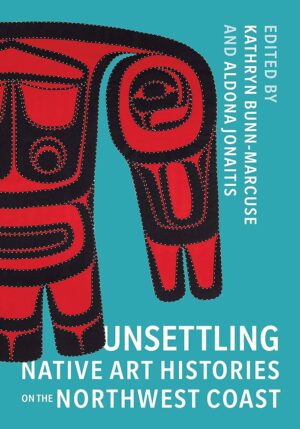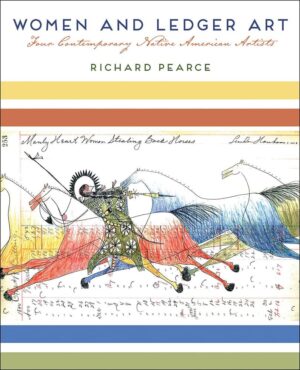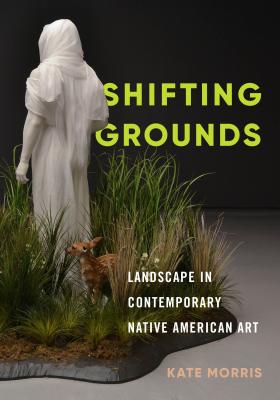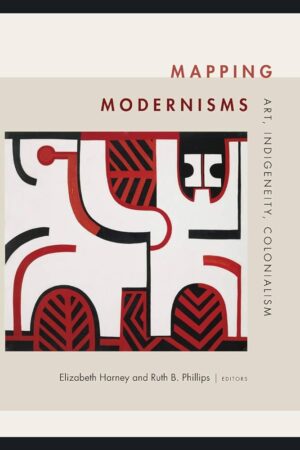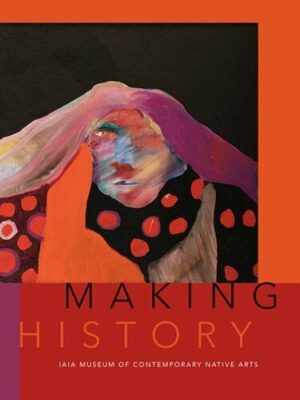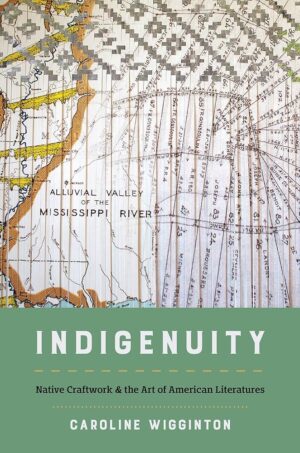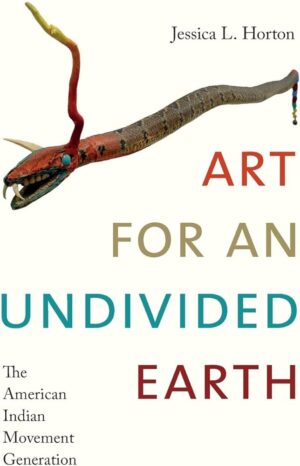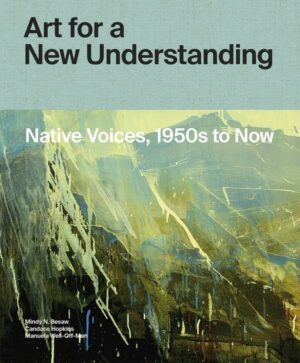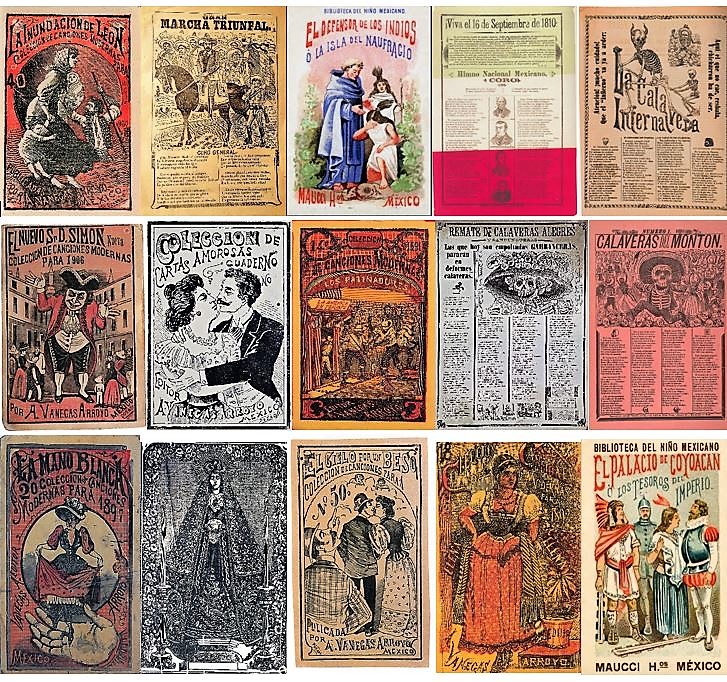Tag: art
Sovetskii Ekran (Soviet Film) Digital Archive at UC Berkeley Library
The Library has purchased the Digital Archive of a Soviet film magazine: Sovetskii Ekran. The archive provides access to the full-text of journal issues that were published from 1925-1998.
Below is the screenshot of the landing page of the Sovietskii Ekran.

At the time of writing this blog, the digitization of issues was completed through 1970 and the additional digitization was in progress.
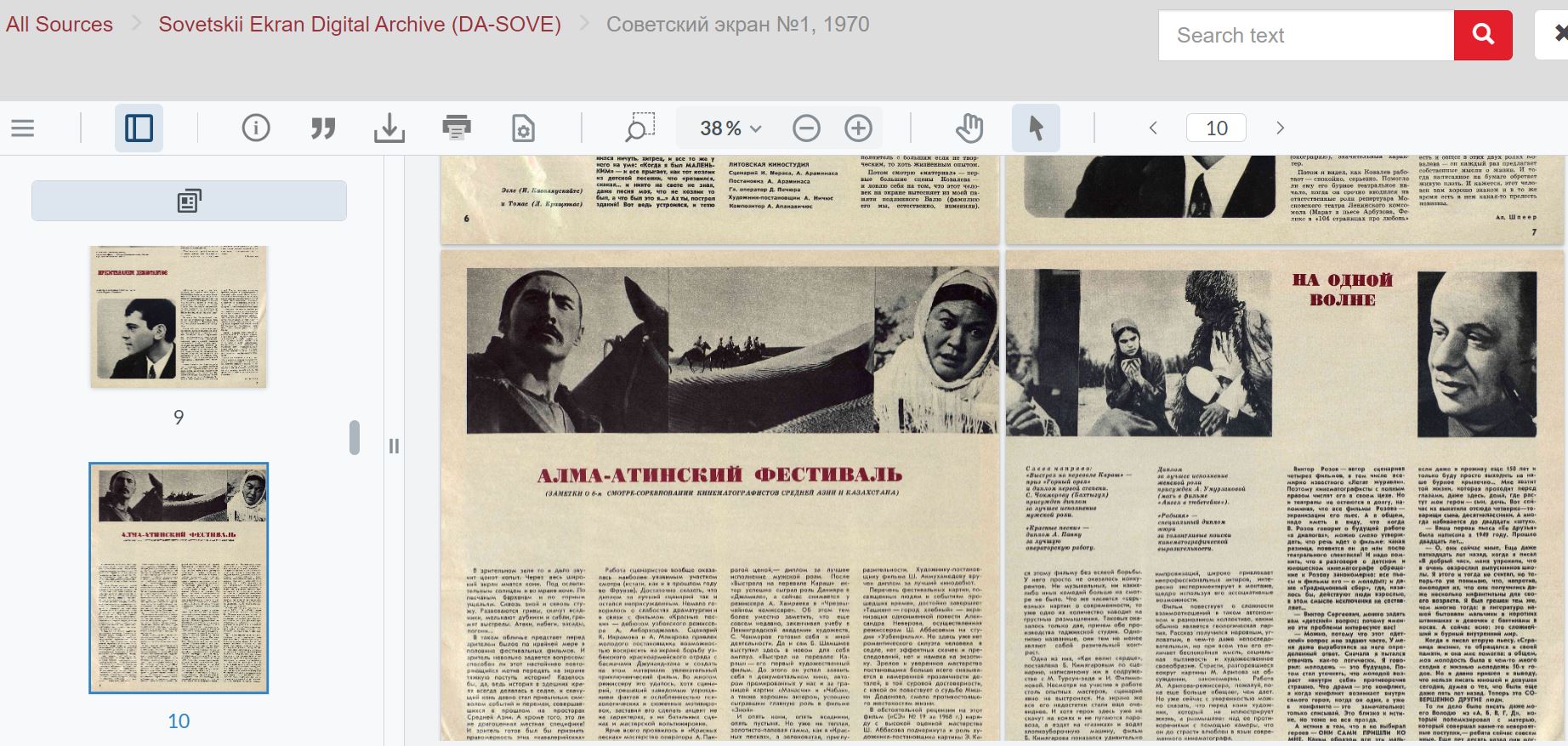
About the journal:
Soviet Screen was a magazine in the USSR that ran from 1925 to 1998 (with a break from 1941 to 1957). It talked about movies, both from the Soviet Union and other countries, cinema history, and had articles critiquing films. They also had reader polls each year to pick the best film, actor, actress, film for children, and music film.
The magazine had different names over the years, like Screen Film Gazeta in 1925, Cinema and Life in 1929–1930, Proletarian Cinema from 1931–1939, and Screen from 1991–1997. Before 1992, it was connected to the Union of Cinematographers of the USSR State Committee for Cinematography and the USSR.
In 1984, they printed 1.9 million copies. In 1991, the editor was Victor Dyomin, and the magazine was published under the title: Screen. It started coming out less often, monthly instead of more frequently. It kept going as Screen Magazine until 1997, then for a few months in 1997-1998, it went back to its old name-Soviet Screen. But it couldn’t survive the financial troubles in 1998 and had to stop publishing (Source: Wikip.).
Native American Heritage Month Art Resources
November is National Native American Heritage Month. Check out these online resources about Native American Art. Come see additional titles on display in the Art History/ Classics Library.
The Sweet Smell of Home Unsettling Native Art Histories… Women and Ledger Art
Shifting Grounds Mapping Modernisms Making History
Indigenuity Art for an Undivided Earth Art for a New Understanding
Senga Nengudi: Black Avant-Garde Visual and Performance Artist
As a continuation of our work for the Getty Research Institute’s African American Art History Initiative (AAAHI), Dr. Bridget Cooks and I conducted several oral history interviews with the avant-garde artist Senga Nengudi. This interview is one of several AAAHI oral histories exploring the lives and work of Los Angeles-based artists, and highlights Nengudi’s contributions to visual and performance art.
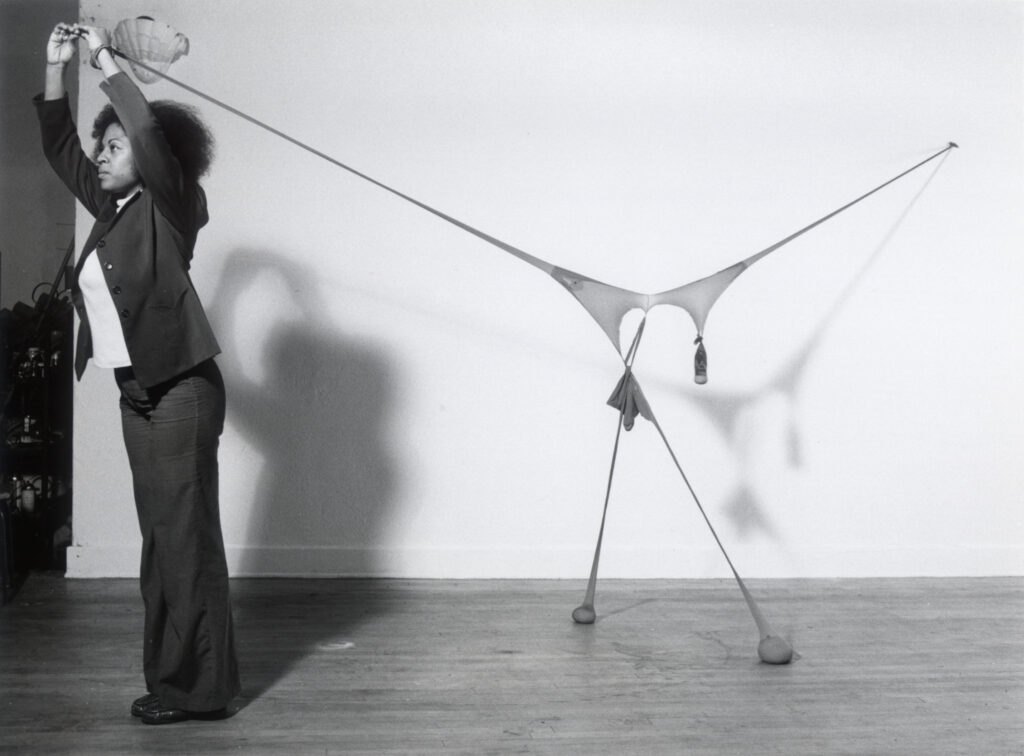
Senga Nengudi is an avant-garde artist best known for her abstract sculpture and performance art. Nengudi was born in Chicago, Illinois, in 1943 and moved to Los Angeles, California, at a young age. She attended California State University, Los Angeles (CSULA) for both her undergraduate and master’s work, as well as completed a program at Waseda University in Tokyo, Japan. Nengudi was active in the avant-garde Black art scenes in Los Angeles and New York during the 1960s and 1970s, and was a member of the Studio Z Collective. She is best known for her R.S.V.P. (Répondez s’il vous plaît) Series featuring pantyhose, which she began in 1975. Nengudi is the recipient of many awards, including the Louis Comfort Tiffany Foundation Award in 2005, the Anonymous Was a Woman Award in 2005, the Denver Art Museum Key Award in 2019, and was elected as a member to the American Academy of Arts and Sciences in 2020. Find this interview and all our oral histories from the search feature on our home page. You can search by name, key word, and several other criteria.
Senga Nengudi was still in elementary school when she and her mother moved to Los Angeles in the early 1950s. Despite a brief stint in New York, for more than thirty years she lived in the greater Los Angeles area first as a child; as a student at CSULA; as an artist and active member of the Studio Z Collection; and as a young mother. That Nengudi called Los Angeles home for so long meant that her formative years of creative expression and early artistic networks sprang from the Southland.
Looking back, Nengudi credits her mother with providing a creative foundation.
“…she was very, very, very conscious of the home and making something home, and so she would decorate the house. And then, say like three years later, she would repaint the walls, she would change the upholstery, she would do all those kinds of things. She was very aesthetically aware, as well as needed a particular beauty in her home to feel good.”
And Nengudi expressed her own creativity through several outlets, remembering, “It’s always been a deal between art and dance with me…” Indeed, during her undergraduate years at CSULA, she chose to major in art and minor in dance—a pairing which supports much of her work.
In the mid-1970s, Nengudi found an outlet to express her love of performance through the Studio Z Collective—a collective of artists interested in improvisation that continued into the 1980s. In addition to Nengudi, Studio Z was comprised of Houston Conwill, David Hammons, Maren Hassinger, and occasionally other artists including Franklin Parker and Ulysses Jenkins. Her relationships with these artists also had a great impact on Nengudi’s artistic career. Thinking of Studio Z’s contribution to her 1978 performance Ceremony for Freeway Fets, which took place under a freeway overpass on Pico Blvd., she muses that “we all kind of supported each other in our efforts.”
Nengudi also found early support from Los Angeles-based gallery owners like Greg Pitts at the Pearl C. Woods Gallery, as well as Brockman Gallery’s Alonzo and Dale Davis. In fact, Brockman Gallery’s dispersal of CETA [Comprehensive Employment and Training Act] funds helped employ artists like Nengudi and Maren Hassinger.
Hassinger remains Nengudi’s longtime creative collaborator. Nengudi recalls that the connection between the two was immediate, “We just kind of instantly became friends, because there was this commonality. She was involved with dance, she was involved with sculpture, all that kind of stuff.” And to why this collaboration with Hassinger has sustained both the passing of years and geographical distance, Nengudi explains:
“Because we believe so much in collaboration. We believe in unity. We believe in bringing the best out in each other…Even though our background is different, our interests are the same. It’s always been dance, performance, sculpture, movement, and this commitment to our art. And when we had some really funky times and we were 2,000 miles apart, the thing that held us together was this commitment to art. And so that kind of carried us through the most difficult things…So all these life events were going on, but the constant was our ability to connect and think and make happen.”
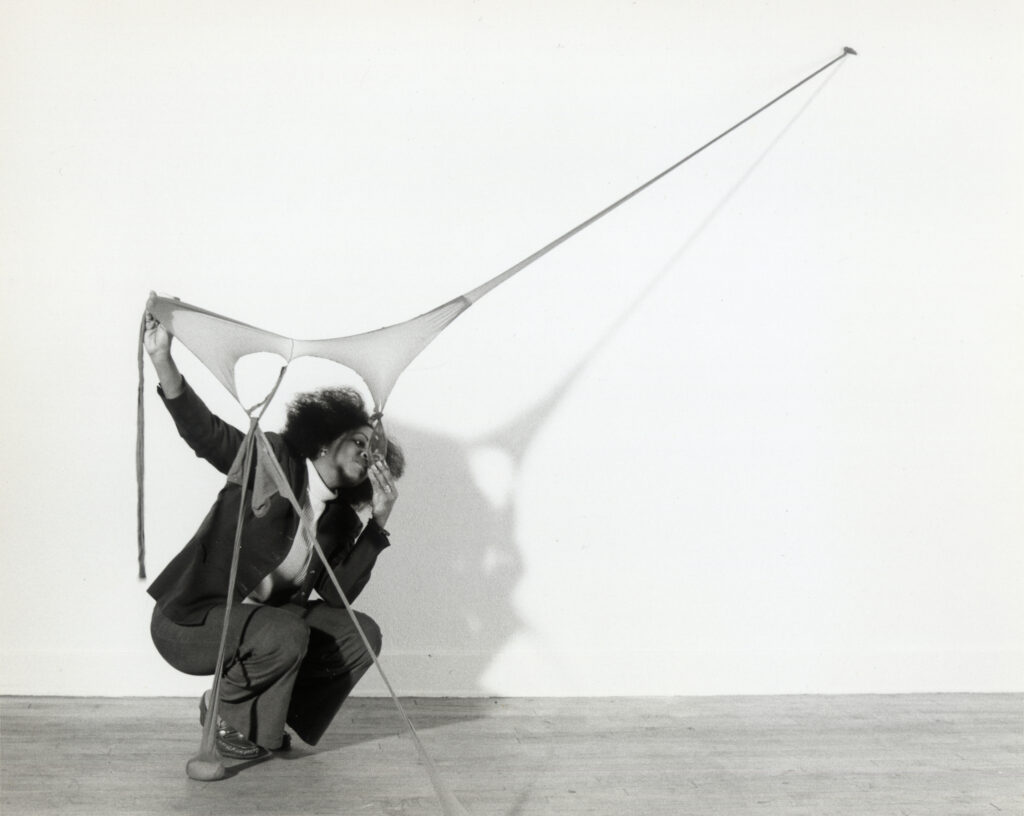
Nengudi’s most recognizable series of work is R.S.V.P., which she started in the mid-1970s. The R.S.V.P. Series, or Répondez s’il vous plaît (respond, please), demonstrated Nengudi’s experimentation with nylon pantyhose. Importantly, Nengudi began working in this medium after the birth of her first son, when she was especially interested in the elastic nature of a woman’s body. She recalls,
“So yes, the explorations were really exciting. I put eggs in them, I broke eggs in them…I used white glue, I used hot glue, which obviously didn’t last that long. I tried everything—resin. Again, it dissolved in the resin. So really, as I was developing the series, it was all about exploring the material…And it took a while to get to…the sand, where I just noticed that…once in the nylons, it had such sensuality to it, because it had this kind of natural body form from the weight of the sand.”
Given the experimental nature of her sand-filled nylon pieces, Nengudi explains, “I thought about them as sculpture first. I did not develop them thinking that I would perform in them.” But Nengudi eventually did embrace the performative potential of these sculptures, even engaging Hassinger to perform with them at the Pearl C. Woods Gallery in 1977 by entwining her body with the material, manipulating it, even dancing with it.
Nengudi has lived in Colorado since the 1980s, and continues to stimulate audiences by creating work that plays with the line between sculpture, installation, and performance in space. However, she has also made significant contributions as an arts educator, especially at University of Colorado at Colorado Springs, and as an advocate of the arts. Namely, she established a community art gallery called ARTSpace in Colorado Springs so that “artists could show their work” and learn “what it takes to have an art exhibit.” The added bonus, of course, was that “the community could come in and see the artwork. It was right there for them.” For someone whose early exposure to creative expression was so formative to her artistic practice, this is a logical next step to engage new generations of artists and viewers. It also connects with her decades-long entreaty to audiences: “respond, please.”
To learn more about Senga Nengudi’s life and work, check out her oral history interview! Find this interview and all our oral histories from the search feature on our home page. You can search by name, key word, and several other criteria.
Oral History Release – Thomas Gaehtgens: Famed Art Historian and Director of the Getty Research Institute
“As a scholar, one’s career typically revolves around teaching, research, and scholarship. Once in a while, a scholar is lucky enough to have a hand in building something. I’d like to think I have helped build a thing or two in my career.”
Such were the words of renowned art historian Thomas Gaehtgens upon wrapping up his oral history at the Getty Research Institute (GRI) in the fall of 2017. That the words held an element of retirement was no coincidence. Gaehtgens had already enjoyed a long and successful academic career before assuming the directorship of the GRI in 2007, a position from which he would officially retire in the spring of 2018. True to form, Gaehtgens met retirement with the same productive stride that had underpinned his work throughout the previous five decades. Thus, after a fruitful delay, the Oral History Center and Getty Trust are pleased to announce the release of Thomas Gaehtgens: Fifty Years of Scholarship and Innovation in Art History, from the Free University in Berlin to the Getty Research Center.
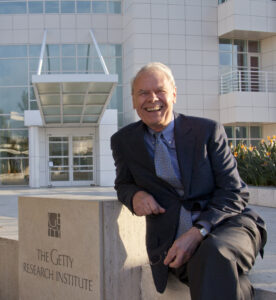
Getty Research Center
For many in the academic and art world of Europe, Gaehtgens needs no introduction. Born in Leipzig, Germany, he completed his PhD in art history at the University of Bonn in 1966, and over the next forty years held professorships at the University of Göttingen and the Free University of Berlin. He is the author of nearly forty publications on French and German art, covering a wide range of topics and artists from the eighteenth to the twentieth century.
Scholarship aside, Gaehtgens also made a mark through his globalist approach to art, fostering relationships that bridged the divides between universities and museums, as well as those between nations. He organized the first major exhibition of American eighteenth and nineteenth century paintings in Germany, expanded the art history curriculum in Berlin to include non-Western areas, and founded the German Center for Art History in Paris. These efforts made him a natural fit for president of the Comité International d’Histoire de l’Art (CIHA), where he advanced initiatives such as the translation of art history literature and broadening the field of art history through international conferences.
Gaehtgens brought this same spirit of inclusivity and innovation to the Getty Research Institute. In many respects, he helped usher the GRI into the twenty-first century by launching a number of programs that not only brought modern technology to the study of art, but also two principles close to Gaehtgens’ heart: international collaboration and equal access for all. The creation of the Getty Provenance Index proved a case in point. In partnership with a host of European institutions, the Index provided a one-stop, digital archive for researchers to trace the ownership of various art pieces over the centuries. Here, for the first time, the records of British, French, Dutch, German, Italian, and Spanish inventories stood at the fingertips of researchers. These same principles of technology, cooperation, and equitable access also underpinned the GRI’s creation of the Getty Research Portal, a free online platform providing access to an extensive collection of digitized art history texts, rare books, and related literature from around the world. Other important achievements of Gaehtgens’ directorship included the Getty Research Journal, a more internationally represented Getty Scholars program, and the Getty’s California-focused art exhibitions, Pacific Standard Time.
Thomas Gaehtgens retired from the Getty Research Institute in 2018, officially ending an art history career that spanned over fifty years. Fittingly, his decades of work have been recognized around the world. He holds honorary doctorates from London’s Courtauld Institute of Art and Paris-Sorbonne University. In 2009, he received the Grand Prix de la Francophonie by the Académie française, an honor bestowed by the Canadian Government to those who contribute to the development of the French language throughout the world. And in 2011, Gaehtgens was elected a fellow of the American Academy of Arts and Sciences. Such honors highlight the indelible mark he left on the global field of art history, one still seen today from the German Center for Art History in Paris to the now-famed digital programs of the Getty Research Institute. Indeed, Thomas Gaehtgens was not just an influential teacher and productive scholar, but also an innovative art historian who helped build a thing or two.
You can access the full oral history transcript of Thomas Gaehtgens here. See also other oral histories from the Getty Trust Oral History Project.
About the Oral History Center
The Oral History Center of The Bancroft Library has interviews on just about every topic imaginable. You can find the interview mentioned here and all our oral histories from the search feature on our home page. Search by name, keyword, and several other criteria. We preserve voices of people from all walks of life, with varying political perspectives, national origins, and ethnic backgrounds. We are committed to open access and our oral histories and interpretive materials are available online at no cost to scholars and the public.
Sign up for our monthly newsletter featuring think pieces, new releases, podcasts, Q&As, and everything oral history. Access the most recent articles from our home page or go straight to our blog home.
Richard Mayhew: Painting Mindscapes and Searching for Sensitivity
In March 2019, Dr. Bridget Cooks and I had the pleasure of conducting a series of oral history interviews with artist and educator Richard Mayhew for the Getty Research Institute’s African American Art History Initiative. Mayhew’s most recognizable work includes paintings of abstract and brightly-colored landscapes—what he calls mindscapes.

Richard Mayhew is a painter, as well as a retired professor of art. He was born on Long Island, New York, and displayed an early interest in art. He studied at the Brooklyn Museum Art School, the Art Students League of New York, the Pratt Institute, and Columbia University. Mayhew received a John Hay Whitney Fellowship in 1958 to live and study in Europe in the early 1960s. He joined Spiral in 1963 and was a member of the Black Emergency Cultural Coalition (BECC). Mayhew has taught at many universities and art institutions, including Hunter College, Pennsylvania State University, San José State University, Sonoma State University, and University of California Santa Cruz.
Find this interview and all our oral histories from the search feature on our home page. You can search by name, key word, and several other criteria.
Mayhew’s interview detailed his incredible life and inventive work, as well as his deep connections to communities of artists across the country, and indeed across generations. For instance, Mayhew was a member of a group of Black artists called Spiral, which met to discuss both their work and their connection to the Civil Rights Movement. Spiral started in 1963 at the urging of A. Philip Randolph of the Brotherhood of Sleeping Car Porters to “form a contingent of artists for the March on Washington” that same year.
Mayhew recalls that “the original group of elders” in Spiral included Charles Alson, Romare Bearden, Norman Lewis, Felrath Hines, and Hale Woodruff. But this soon became an intergenerational group. In speaking about the formation of Spiral, Mayhew also remembers its network of visual and performing artists across the country:
“But also, [A.] Philip Randolph wanted not just the visual artists, he wanted all African American artists that wouldn’t be in the New York area. So we called the artists in Missouri and Chicago and also Los Angeles about this idea that Philip Randolph wanted a contingent of artists. So they made contact with them over there. We didn’t have all the people together, so Ralph Ellison came there and he was talking about—I don’t remember all the names now of the composers, and also directors of the theaters in New York which were Afro-American. That was part of the idea, the contingent not just be the visual artists, but all the areas of arts in that area.”
Another unique aspect of this interview was Mayhew’s reflection on his African American and Indigenous backgrounds, and how they influenced his relationship to art and nature. In thinking about how his identity connected to his artistic vision, Mayhew explained,
“Mine was more out of the African American and Native American heritage, in terms of the love of nature and also the respect for nature, because nature’s involved in reinventing itself. That was what’s going on, in terms of African American and Native American sensibility. They constant[ly] reinvented themsel[ves] and constantly grew and matured and survived. That was my connection to nature and the fascination, almost until today. I’m still trying to paint that feeling.”
To learn more about Richard Mayhew’s life and work, read his oral history transcript here. Find this interview and all our oral histories from the search feature on our home page. You can search by name, key word, and several other criteria.
Charles Gaines: The Criticality and Aesthetics of the System
As a continuation of our work for the Getty Research Institute’s African American Art History Initiative, Dr. Bridget Cooks and I conducted a series of oral history interviews with the conceptual artist Charles Gaines. This interview was the first of several exploring the lives and work of Los Angeles-based artists, and celebrates Gaines’s extraordinary artistic contributions.
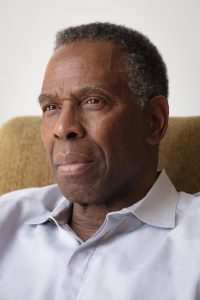
Charles Gaines is an artist specializing in conceptual art, as well as a professor of art at California Institute of the Arts. Gaines was born in South Carolina in 1944, but grew up in Newark, New Jersey. He attended Arts High School in Newark, graduated from Jersey City State College in 1966, and earned an MFA from the School of Art and Design at the Rochester Institute of Technology in 1967. Beginning in 1967, he taught at several colleges, including Mississippi Valley State College, Fresno State University, and California Institute of the Arts. Gaines has written several academic texts, including “Theater of Refusal: Black Art and Mainstream Criticism” in 1993 and “Reconsidering Metaphor/Metonymy: Art and the Suppression of Thought” in 2009. His influential artwork includes Manifesto Series, Numbers and Trees, and Sound Text; and he exhibited at the Venice Biennale in 2007 and 2015. Gaines is the recipient of several awards, including Guggenheim Fellowship in 2013 and REDCAT Award in 2018. Find this interview and all our oral histories from the search feature on our home page. You can search by name, key word, and several other criteria.
Hearing about Charles Gaines’s upbringing was especially helpful in framing his approaches to art. For example, he spoke about his mother’s influence on his life–particularly her musical inclinations. Though Gaines concentrated his early artistic studies on the visual arts, he also had a passion for music, eventually becoming a professional drummer. This connection to musicality and music theory features prominently in his conceptual works like Snake River and Manifestos. Indeed, in his Manifestos Series, Gaines turned the text of political manifestos into musical compositions based on a system he devised. He recalled, “Unconsciously, I began thinking about music as a kind of mathematics and this connection with text and language; I began to see the connection to language and systems.”
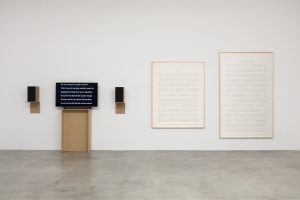
speakers, hanging speaker shelves. Photograph by Frederik Nilsen.
Further, Gaines shared about his exploration of conceptual work in the 1970s, and his consequential transition from an abstract painter to a conceptual artist:
Well as I said, those big abstraction paintings turned into these process-oriented works, and so that work demonstrated an interest in a systematic approach. It was a part of my research. I was looking for an alternate way of making work that was not based upon the creative imagination, was not based upon subjective expression.
This transition period also coincided with an eighteen-month sabbatical from teaching at Fresno State University from 1974 to 1975, when Gaines, his wife, and infant son moved to New York to explore his professional art practice. He recalled of the conceptual artists he met there:
But I did at that time, during that time in New York, become much more familiar with conceptualists, with what the conceptualists were doing. At that time, it provided a context for me. It was just before I started working with numbers but I was working with systems already, and so I felt that it’s true that, of anybody, my work, the language of my work fits best with those conceptualists.
Another major theme in Gaines’s interviews was his many years teaching art at colleges across the country, including the challenges of teaching at what he deemed conservative institutions. Despite these challenges, Gaines always looked for ways to mentor his students by not only helping them improve the quality of their work, but also by sharing his own insights into how to navigate the art world. He explained:
The thing I would always give my students advice about is that you can’t control career. That’s something that you shouldn’t even be thinking about. You should only think about the work, and you should also think about exhibiting the work, which I think is different from a career. You need to show people the work, so you make the work and try to get people to see it. In that process, something might happen, you can’t make it happen. In almost every story about how careers get kicked off, it’s because you happen to be at a right place at the right time, and somebody who matters notices something, and then things sort of roll into place…Ultimately, it’s the work that’s going to get you the exposure.
In addition to his own works and teaching career, Gaines has also made many important contributions to the art world through his theoretical writing and curation of exhibitions. In 1993, he co-curated Theater of Refusal: Black Art and Mainstream Criticism with Catherine Lord at the University of California, Irvine in 1993. This show, and Gaines’s catalog piece, explored racism in the art world by displaying Black artists’ work alongside reviews from (largely white) art critics, and questioned how and why they misread this work. Of this important exhibition, Gaines explained:
Well, I chose artists who were actively producing in the art world, and known to people. In a couple of cases, I showed a couple of people who were at an early part of their career, like Renée Green, for example, just started her career. But there were other people like Lorna Simpson and Fred Wilson, Adrian Piper, were completely well-known. The fact that they’re well-known artists was important to me because it allowed me to underscore this point that I was making: that is that there’s not much writing on the work of artists, even if they’re well known. The writing that there is [is] marginalized around the idea of race. The writers who wrote about [them] often thought they were writing positively about the work. They didn’t think that the way they approached the work was, in fact, marginalizing.
To learn more about Charles Gaines’s life and work, check out his oral history interview! Find this interview and all our oral histories from the search feature on our home page. You can search by name, key word, and several other criteria.
David C. Driskell: Life Among the Pines
In April 2019, Dr. Bridget Cooks and I had the privilege of conducting a series of oral history interviews with artist and educator David C. Driskell for the Getty Research Institute’s African American Art History Initiative. David and his wife, Thelma, welcomed us into their home, where we spent hours speaking with David about his singular life and extraordinary contributions to art and African American art history. It was a surreal experience to sit behind the camera and look around at beautiful works of art while David skillfully engaged us with stories from his life and work. In recounting his past, David employed accents and well-timed jokes that had us in stitches. It was a pleasure to watch a gifted storyteller at work.
One year later, I learned from Bridget that this kind, funny, and smart man had passed away from complications due to the coronavirus on April 1, 2020. In a year filled with so much loss and change, David’s passing still hit hard. With David’s passing, the world lost not only a bright personality, but also a brilliant mind who championed the field of African American art history. And despite the uncertainty of these early days of the pandemic, I am happy to say that the Oral History Center was able to expedite the finalization of David’s oral history transcript, which is now available to the public.
Now another April has arrived. At the Oral History Center our work remains remote, but people across the country have been vaccinated against the coronavirus, and there is hope that the end of the pandemic is in sight. It is past time to take stock and reflect on those we have lost and the stories that remain with us. For me, David Driskell’s interview is one such story with staying power.
David C. Driskell was an artist and professor of art. He was born in Georgia in 1931, but mainly grew up in North Carolina. Driskell graduated from Howard University with a degree in painting and art history in 1955, attended the Skowhegan School of Painting and Sculpture in 1953, and earned an MFA from Catholic University in 1962, as well as a study certificate in art history from Rijksbureau voor Kunsthistorische Documentatie in 1964. Beginning in 1955, he taught at several colleges, including Talladega College; Howard University; Fisk University; and the University of Maryland, College Park. His influential artwork includes Young Pines Growing, Behold Thy Son, Of Thee I Weep, and Ghetto Wall #2. Driskell has curated important shows highlighting African American art history, including Two Centuries of Black American Art and Hidden Heritage: Afro-American Art, 1800-1950. He also helped establish The David C. Driskell Center for the Study of Visual Arts and Culture of African Americans and the African Diaspora at the University of Maryland, College Park, in 2001. Find this interview and all our oral histories from the search feature on our home page. You can search by name, key word, and several other criteria.
Throughout his many years making art, David experimented with different media and subjects, often with the recurring theme of pine trees. Yet one of his most memorable pieces is Behold Thy Son from 1956, which is now at the Smithsonian’s National Museum of African American History and Culture. David painted this pietà – a subject in Christian art depicting the Virgin Mary cradling the dead body of Jesus – in response to the 1955 murder of Emmett Till. For many observers, this image captured the zeitgeist of the early Civil Rights movement.
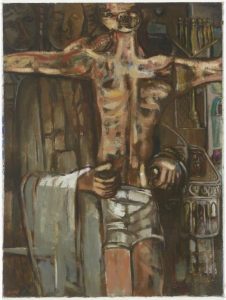
Listen as David speaks about making this important piece:
When Bridget asked how David felt about Behold Thy Son over sixty years after painting it, he replied, “I think it is dated and tied to a time and period, but the fight goes on. It’s also showing you that time hasn’t changed that much. [Eric Garner and] ‘I can’t breathe.’ ” Indeed, the subject of violence against Black bodies remains tragically evergreen.
And yet, in part because of this turmoil for African Americans at midcentury, David found renewed artistic inspiration in the serenity of nature – especially pine trees. Listen as he explains this shift in his work:
David was indeed a talented artist and important educator, as Bridget eulogized so well in her obituary on ArtForum last year. But our oral history interviews with him also highlighted the fact that he was a deeply religious man, one who connected his spirituality and creativity with his passion for gardening. During an interview session after church on Palm Sunday, David said of these links between nature and religion, “From dust and dirt thou came, and so dust to dirt thou goest. I’ve got to be part of that process.”
He further explained:
“So gardening is to me like painting, in a way. It’s a part of the process of this creative spirit that I feel so close to. Can’t wait to get [to the house in Maine] and I often go to the garden before I go to the studio…Gardening is a part of my life. It’s a part of that kind of spiritual regeneration that comes with the natural process. It isn’t for me so much the biblical reference.”
As a further measure of the man, when we were wrapping up our final interview session, we asked David for his concluding thoughts, and he said, “Well, maybe the final say is none of this I could be doing without family.” He went on to praise his wife, Thelma, in particular for supporting his art career when it was just a dream.
To learn more about David C. Driskell’s extraordinary life and work, read his oral history transcript and watch his interview in full here, here, and here. Find this interview and all our oral histories from the search feature on our home page. You can search by name, key word, and several other criteria.
Library’s Wikipedia Edit-a-Thon: Coming Soon (3/10) to a Screen Near You!
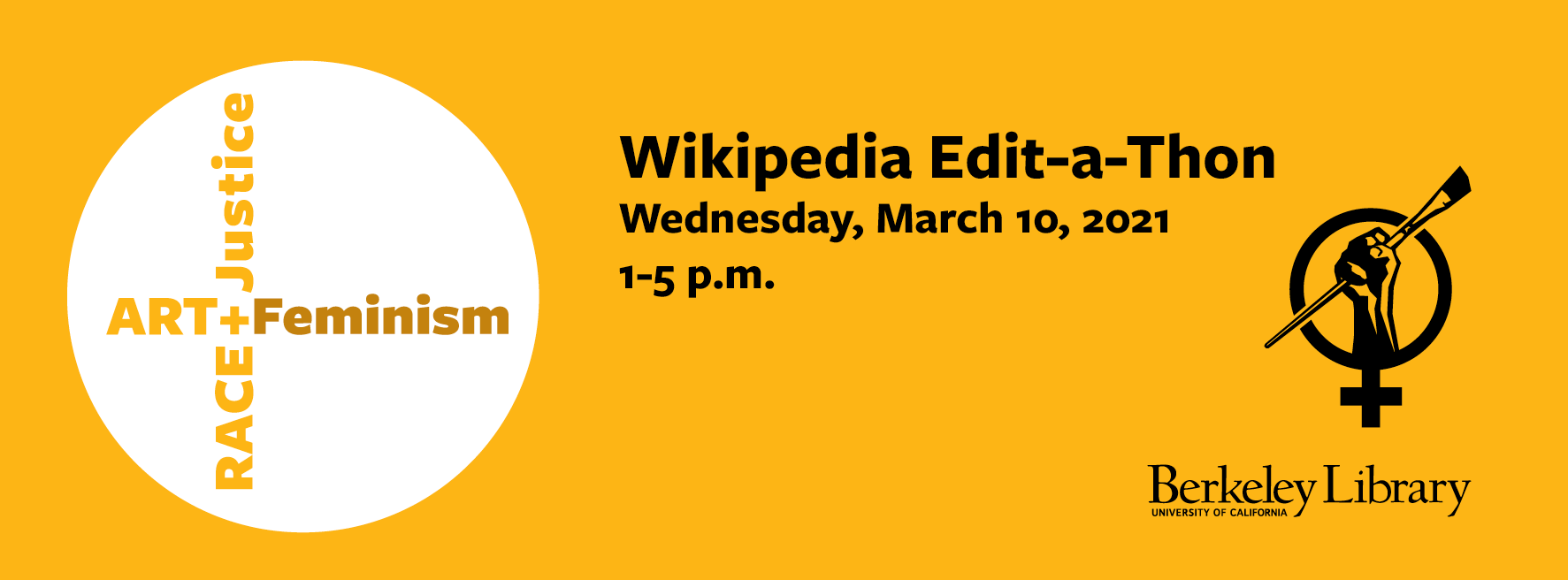
For many of us in the library, last year’s Wikipedia Edit-a-Thon on March 4 was the final program we held in person before the pandemic lockdowns (we actually wondered at the time whether attendance would be down due to the spread of the virus, but we had a great crowd).
Happily for us, the edit-a-thon, which is an event that gathers people together to expand and improve on the amazing information resource Wikipedia, can easily transition to an online format! The National Network of Libraries of Medicine has been holding national online edit-a-thons for years, and there are many other wonderful offerings, themed and general, to take advantage of online (check out this set of events “Honoring Indigenous Writers” from the University of British Columbia).
So, this year, our edit-a-thon will be virtual. Please come edit with us on Wednesday, March 10, from 1:00-5:00 PM! (or any portion of that time that works for you) We’ll use Zoom as a way to hold our guest speaker session and workshops on how to edit, and we will even have breakout rooms for the various editing preferences and needs of attendees. More information and the schedule can be found here; the only thing you need to do is register using this form (in order to get the Zoom link), and show up online on the day! (It would also be great, if you want to actually edit, to set up your Wikipedia account in advance)
And, about the guest speaker aspect of the event—this year, we are thrilled to offer a two-hour Wikipedia workshop (from 1:00-3:00 PM) created and led by Dr. Alexandria Lockett, from Spelman University in Atlanta, GA. Dr. Lockett will discuss how both new and experienced editors can meaningfully contribute to underrepresented knowledge of Wikipedia through alternative research practices.
Questions? Feel free to email us at editathon@lists.berkeley.edu, and we hope to “see” you on March 10!
Come Edit with Us! (at the Wikipedia Edit-a-Thon, 3/4/20)

Umberto Eco, author of The Name of the Rose, said, “The cultivated person’s first duty is to be always prepared to rewrite the encyclopedia.” But, in the case of Wikipedia, we actually get to write the encyclopedia! If you are interested in Wikipedia as a phenomenon and what happens behind the scenes, in learning to edit, and/or in improving the quality and diversity of content in this important resource, join us at the upcoming Art + Feminism + Race + Justice Wikipedia Edit-a-Thon.
Why is this so important, anyway? It’s because Wikimedia’s race and gender trouble is well-documented. While the reasons for the gap are up for debate, the practical effect of this disparity is not: content is skewed by the lack of participation by women and underrepresented groups. This adds up to an alarming absence in an important repository of shared knowledge, which many groups are starting to address.
Art+Feminism is a national campaign improving coverage of cis and transgender women, non-binary folks, feminism and the arts on Wikipedia, and at UC Berkeley we have teamed up with the American Cultures program’s Race+Justice edit-a-thon. Edit-a-thons are a powerful way to address Wikipedia’s gaps in content. The Library is also joined in sponsorship of the event by 150 Years of Women at Berkeley, and suggested editing needs will include topics related to Berkeley alumnae of note.
So, join us in 405 Moffitt Library on Wednesday, March 4 between 11:00am and 5:00pm for an all-day communal updating of Wikipedia entries. Drop in any time! We will provide tutorials for the beginner Wikipedian, reference materials, and refreshments. Check out the schedule at bit.ly/wiki-berkeley for timing of informative talks, instruction sessions, and more. Set up your Wikipedia editing account in advance, or we can help you on the day. Bring your laptop, power cord and ideas for entries that need updating or creation! For the editing-averse, we urge you to stop by to show your support. People of all races and gender identities are invited to participate.
See you there!
NOTE: A Cal ID card is required to enter Moffitt, so those without a Cal ID card need to RSVP to attend the event by March 3.
The Library attempts to offer programs in accessible, barrier-free settings. If you think you may require disability-related accommodations, please contact us.
New exhibition: Illustrating México One Page at a Time: Print Art of José Guadalupe Posada
Title of Exhibit: Illustrating México One Page at a Time: Print Art of José Guadalupe Posada
Time: 9 a.m.-10 p.m. (regular Moffitt hours on Saturdays)
Location: Moffitt Library gallery, 3rd floor
Description:
In the pantheon of artists who have represented Mexico for the past 150 years, José Guadalupe Posada stands out as a bright constellation. This exhibit, highlighting works by Posada and his artistic descendants, was curated by Liladhar Pendse, librarian for the Caribbean and Latin American Studies Collections, using Doe Library materials. See more at exhibits.lib.berkeley.edu/spotlight/art-of-posada.

